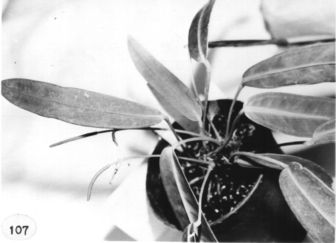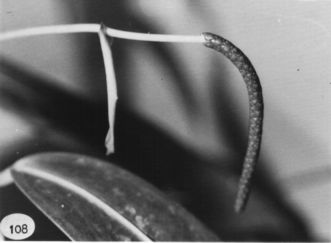





Anthurium longistipitatum Croat, sp. nov.
TYPE: Panama. Chiriquí: along road between Gualaca and the Fortuna Dam site on the Río Chiriquí, 22.7 mi. beyond the bridge over the Río Esti, 11.8 mi. N of Los Planes de Homito, 10.7 mi. N of jet. to tunnel. Croat 48670 (MO 2738911, holotype; K, PMA, isotypes; Live at MO).
Planta epiphytica; cataphyllum modice coriacea-persistens in fibris grossis; peliolus teres, 4.5-36 cm longus; lamina modice coriacea, oblongo-lanceolataad ligulata, basi obtusa ad rotundata, utrinque glanduloso-punctata; inflorescentia arcuata ad pendula; pedunculus teres 12-34 cm longus; spatha membranacea. viridis interdum purpurea, lanceolata, 2-10 cm longa. 4-10 mm lata; stipite 1-4 cm longo (raro 6 cm); spadix rubro-brunneus, atropurpurascens, 4.5-20 cm longus: baccae subglobosae, rubrae, ca. 5 mm diam.
Epiphyte; stems less than 20 cm long, 1.5-2 cm diam.; roots few, greenish to brown, descending; leaf scars ca. 1 cm diam.; cataphylls moderately thick, 3.5-6 cm long, drying reddish brown, soon weathering to coarse brown fibers. persisting around base of leaves and around stem.
LEAVES erect-spreading; petioles 4.5-36 cm long, 2.5-3.5 mm diam., terete, green with sparse. inconspicuous, purplish glands; geniculum 1-1.5 cm long, weakly sulcate; blades moderately thick. oblong-lanceolate to strap-shaped, gradually acuminate at apex, obtuse to rounded at base. (9-) 13-46 cm long, (1.5-)3-7 cm wide, broadest at about the middle (rarely below the middle). the margins straight, revolute; upper surface matte, obscurely dark glandular-punctate, weakly papillate; lower surface semiglossy, conspicuously dark glandular-punctate; midrib acutely raised above nearly to apex, obscurely raised near base below, flat toward apex; primary lateral veins (5-) 10-20 per side, departing midrib at ca. 45° angle, scarcely visible above, weakly sunken below, drying prominulous above and below; lesser veins inconspicuous, drying prominulous; collective veins arising from the base, straight or weakly loop-connected, 3-6 mm from margin.
INFLORESCENCE arching to pendent, shorter than leaves; peduncle erect to arching, terete. faintly tinged red-violet, 12-34 cm long; spathe thin, green, sometimes violet purple or only the margins tinged violet purple, lanceolate, 2-10 cm long, 4-10 mm wide, broadest near the base, abruptly acuminate at apex, usually withering promptly, inserted at a 10° angle on peduncle; stipe 1-4 cm long (rarely to 6 cm), green; spadix reddish brown, becoming dark violet purple, 4.5-20 cm long, 4 mm diam. midway, slightly tapered to apex; flowers weakly 4-lobed, 2.5÷3 mm in both directions, the sides more or less straight parallel to spirals, sigmoid perpendicular to spirals, 3-4 flowers visible in the principal spiral, 6-8 flowers visible in the alternate spiral; tepals glossy, lateral tepals 1.4÷1.8 mm wide, the inner margin broadly rounded; pistils weakly raised, reddish purple; stigma linear, ca. 0.3 mm long; stamens emerging rapidly, beginning near the base, the laterals emerging to the middle or just above before the first alternate emerges, the third stamen preceding the fourth by only ca. 2 spirals, persisting after anthesis; anthers white, held at sides of pistil just above tepals, ca. 0.3 mm long, 0.6 mm wide; thecae more or less rounded, slightly divaricate; pollen yellow, fading to white.
INFRUCTESCENCE pendent; berries subglobose, red, ca. 5 mm diam.; mesocarp gelatinous;m seeds 1, tan, weakly flattened, 2.5-2.7 mm long, 1.5-2 mm wide, 0.7-1 mm thick. Figs. 107 and 108.
Anthurium longistipitatum is endemic to Panama in Chiriquí Province at 1,250 to 1,700 m in premontane and lower montane rain forest. Most collections are from the Fortuna Dam site but the species is known also from Cerro Colorado, north of San Felix and from Cerro Pata de Macho, northwest of Boquete.
Anthurium longistipitatum, a member of section Porphyrochitonium, is recognized by its pendent habit (usually suspended by only a few roots), its short, slender stem with cataphylls persisting as coarse fibers, and by its moderately long-petiolate, coriaceous, glandular-punctate, generally strap-shaped, gradually acuminate leaves. Also characteristic are its long-pedunculate inflorescence with a generally longstipitate (thus the name), long, slender, reddish brown to violet purple spadix and its small, globular, red berries. Anthurium longistipitatum is perhaps most easily confused with A. circinatum, which differs in having proportionally much shorter, ovate-oblong leaves that are usually broadly rounded at the base. The latter also has flowers that differ in that they are proportionately larger with the lateral tepals having thin margins drying about three times wider in the direction of the axis than perpendicular to the axis. In contrast, the flowers of A. longistipitatum have thick margins and dry less than two times longer in the direction of the axis. In addition, A. circinatum has stamens that are prominently exscrted on dried specimens whereas those of A. longistipitatum are usually scarcely or not at all exserted on dried specimens. One collection, Mori & Kallunki 58:3 from Cerro Colorado, is unusual in that the stamens are somewhat exserted. For additional characteristics separating the two species see the discussion of A. circinatum.
Anthurium longistipitatum is also related to. A chiriquense but that species differs m having thinner, oblong-elliptic blades that are prominently three-veined with the collective veins arising at an acute angle to the midrib at the base.In contrast, the collective veins of. A. lonpstipitatum are diminished toward the base and follow the margin more closely. Smaller collections of Anthurium wendlingeri may also be confused with A. longistipitatum but that species ranges no further west than Veraguas in Panama and extends no higher than 900 m. It also has much thicker, more elongate blades with the collective vein proportionately more remote from the margin and a longer, proportionately less stipitate spadix that is grayish white or cream-colored at anthesis and produces orange berries.
 |
 |
Map of Mesoamerican specimens with coordinates
Costa Rica Lim—n: P.N. Cordillera de Talamanca; Cordillera de Talamanca,
1900 m, 09.21.25N 83.13.20W, 22 March 1993, Alvaro Fernandez 782 (CR, INB).
Panama : Fortuna or Cerro Colorado,, 20 May 1991, Ingram & Atwood
980 (MO).
Panama : 1450-1480 m, 8.35N 81.50W, 6 July 1988, Thomas B. Croat 69072
(MO).
Panama : 1500 m, 8.35N 81.50W, 8 July 1988, Thomas B. Croat 69175 (CR,MEXU,MO,PMA,US).
Panama Bocas del Toro: 1150 m, 8.45N 82.15W, 22 Oct. 1985, Gordon McPherson
7231 (MO).
Panama Bocas del Toro: 1100-1750 m, 8.35N 81.54W, 27-31 Mar 1986, Barry
Hammel & J. Trainer 14917 (MO).
Panama Bocas del Toro: 1600 m,, 20 June 1986, Kress et al. 86-1926
(SEL).
Panama Chiriquí: 1100-1135 m, 8.43N 82.17W, 8 March 1985, T.B. Croat
& M.H. Grayum 60081 (MO).
Panama Chiriquí: Fortuna Dam Area, 1200 m, 8.41N 82.13W, 9 March 1985,
Hampshire & Whitefoord 372 (BM).
Panama Chiriquí: 1250 m, 8.45N 82.15W, 28 April 1986, Gordon McPherson
9102 (MO).
Panama Chiriquí: Fortuna Dam Area, 1200-1300 m, 8.45N 82.18W, 22 Jun
1987, Croat 66621 (MO).
Panama Chiriquí: 1150 m, 8.45N 82.15W, 23 Oct. 1985, Gordon McPherson
7265 (MO).
Panama Chiriquí: 1100 m, 8.45N 82.13W, 23 May 1984, H.w. Churchill
5261 (MO).
Panama Chiriquí: 1100 m, 8.45N 82.13W, 8 Feb. 1984, H.W. Churchill,
G. de Nevers & H. Stockwell 4816 (MO).
Panama Chiriquí: 1100 m, 8.45N 82.13W, 8 Feb. 1984, H.W. Churchill,
G. de Nevers & H. Stockwell 4817 (MO).
Panama Chiriquí: 1200 m, 8.47N 82.13W, 6 Feb.1984, H.W. Churchill,
G. de Nevers & H. Stockwell 4659 (MO).
Panama Chiriquí: 08.45N 82.18W, 23 June 1994, Thomas B. Croat &
Guanghua Zhu 76301 (CR, MO, NY).
Panama Chiriquí: Cerro Colorado, 1660 m, 8.30N 81.46W, 30 Mar. 1993,
Thomas B. Croat 74988 (L, MO).
Panama Chiriquí: 1400 m,, 26 Nov. 1979, Thomas B. Croat 48670 (MO).
Panama Chiriquí:, 7 December 1997, D.W. Roubik & L. Quroz 1275
.